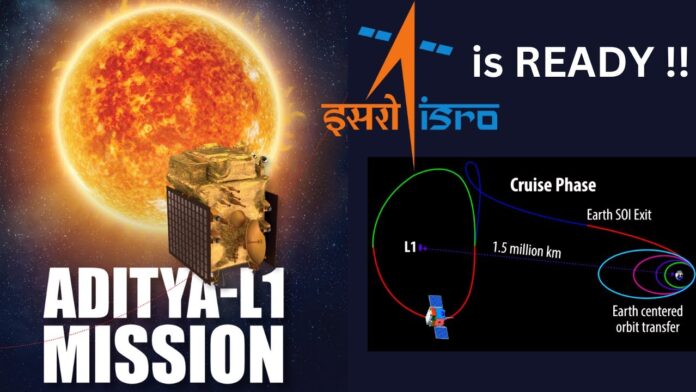
Aditya-L1 day lunching date: What is ISRO’s Sun mission 2023, what it will study
Aditya-L1 mission 2023 spacecraft – The Aditya-L1 mission spacecraft, according to ISRO, will be put into orbit around Lagrange point 1 in the Sun-Earth system. What is point 1 of the Lagrange? What precisely will the Aditya-L1 mission 2023 study? Why is it essential to comprehend solar phenomena?
The Indian Space Exploration Association (ISRO) has reported that the Aditya-L1 mission, the primary space-based Indian observatory to concentrate on the Sun, will be sent off on September 2 from Sriharikota.
“The spacecraft will be placed in a halo orbit around the Lagrange point 1 (L1) of the Sun-Earth system, which is about 1.5 million km from the Earth,” reads a press release from ISRO. The primary advantage of a satellite in the halo orbit around the L1 point is that it can observe the Sun continuously without occultation or eclipse.
This will give a more noteworthy benefit of always noticing the sun-powered exercises and their impact on space weather conditions.”
What is point 1 of the Lagrange? What precisely will the Aditya-L1 mission concentrate on close to the Sun? Why is noticing and understanding sun-oriented peculiarities significant?
Where is the Aditya-L1 mission 2023 going?
The spacecraft will be placed in orbit around the L1 point, where it will be able to observe the Sun unhindered, according to the ISRO press release. A Lagrange point, as characterized by NASA, is a situation in space where “the gravitational draw of two enormous masses exactly rises to the centripetal power expected for a little item to move with them.
Spacecraft can use these points in space to cut down on the amount of fuel they use to stay in place. This basically means that when that happens, the gravitational attraction and repulsion between two celestial bodies are so strong that a thing placed in between them will stay in the same relative position while moving with them.
The Lagrange focuses are named to pay tribute to Italian-French mathematician Josephy-Louis Lagrange, and there are five of them: L1, L2, L3, L4, and L5. As per NASA, “The L1 point of the Earth-Sun framework bears the cost of a continuous perspective on the Sun and is as of now home to the Sun oriented and Heliospheric Observatory Satellite SOHO.
“The James Webb Space Telescope of NASA is located at L2. What is extraordinary about this circle is that it allows the telescope to keep straight with the Earth as it moves around the Sun. According to NASA’s website, this enables the satellite’s substantial sunshield to shield the telescope from the heat and light of the Sun, Earth, and Moon.
What will the Aditya-L1 mission 2023 study?
The shuttle conveys seven payloads to notice the photosphere [the most profound layer of the sun we can straightforwardly observe], chromosphere [the layer around 400 km and 2,100 km over the photosphere], and the furthest layers of the Sun (the crown), utilizing electromagnetic and molecule and attractive field identifiers.
Of the seven payloads, four will straightforwardly concentrate on the Sun, and the excess three will in situ concentrate on particles and fields at the Lagrange point L1, “in this way giving significant logical investigations of the propagation impact of sun-based elements in the interplanetary medium,” ISRO says.
“The suits of Aditya L1 payloads are supposed to give the most critical information to comprehend the issue of coronal warming, coronal mass launch, pre-endlessly flare exercises, and their qualities, elements of room climate, proliferation of molecule and fields, and so on.,” the ISRO statement states.
Why is it important for to Aditya-L1 study the Sun 2023?
Each planet, including Earth and the exoplanets past the Nearby planet group, develops — and this advancement is represented by its parent star.
The weather of the entire system is influenced by the weather and environment of the sun. Varieties in these weather conditions can change the circles of satellites or abbreviate their lives, disrupt or harm locally available gadgets, and cause power outages and different aggravations on The planet.
Understanding space weather requires an understanding of solar events. Continuous solar observations are required to learn about, track, and predict the impact of Earth-directed storms. Each tempest that rises up out of the Sun and heads towards Earth goes through L1.
What are the payloads the Aditya-L1 mission 2023 will carry?
The following is the Remote Sensing Payloads, as stated by ISRO, that will investigate the Sun: Noticeable Outflow Line Coronagraph (VELC) for crown/imaging and spectroscopy; Solar Ultraviolet Imaging Telescope (SUIT), which can be used to image the photosphere and chromosphere; Sun oriented Low Energy X-beam Spectrometer (SoLEXS), which is a delicate X-beam spectrometer for Sun-as-a-star perception; furthermore, High Energy L1 Circling X-beam Spectrometer (HEL1OS), which is a Hard X-beam spectrometer for Sun-as-a-star perception.
The following are the payloads that will be used to study the L1 in situ (at their location): Aditya Sun-based breeze Molecule Analysis (ASPEX), for sun-oriented breeze/molecule analyzer protons and heavier particles with headings; Plasma Analyzer Package for Aditya (PAPA), with directions for the solar wind/particle analyzer; also, High-level Tri-hub High Goal Computerized Magnetometers for in situ attractive field study.
—————————The End—————————
www.GKDuniya.in will refresh a lot more new positions and study materials and test refreshes, continue To visit and share our post of Gkduniya.in, So more individuals will get this. If you have any objections regarding this post, content, links, or notes, please get in touch with us at gkduniyacomplaintbox@gmail.com. You can also follow and subscribe to other social platforms. All social site links are in the subscribe tab and bottom of the page.
Important Links
You-tube :- GKDuniya9
Instagram :- GKDuniya.in
Facebook :- GKDuniya.in
Twitter :- GKDuniya.in
Linked-in :- GKDuniya.in
Pinterest :- GKDuniya.in
Google Rank :- Gkduniya
Other website :- Gk.gkduniya.in, Digitalrobot.in, portfolio.gkduniya.in
